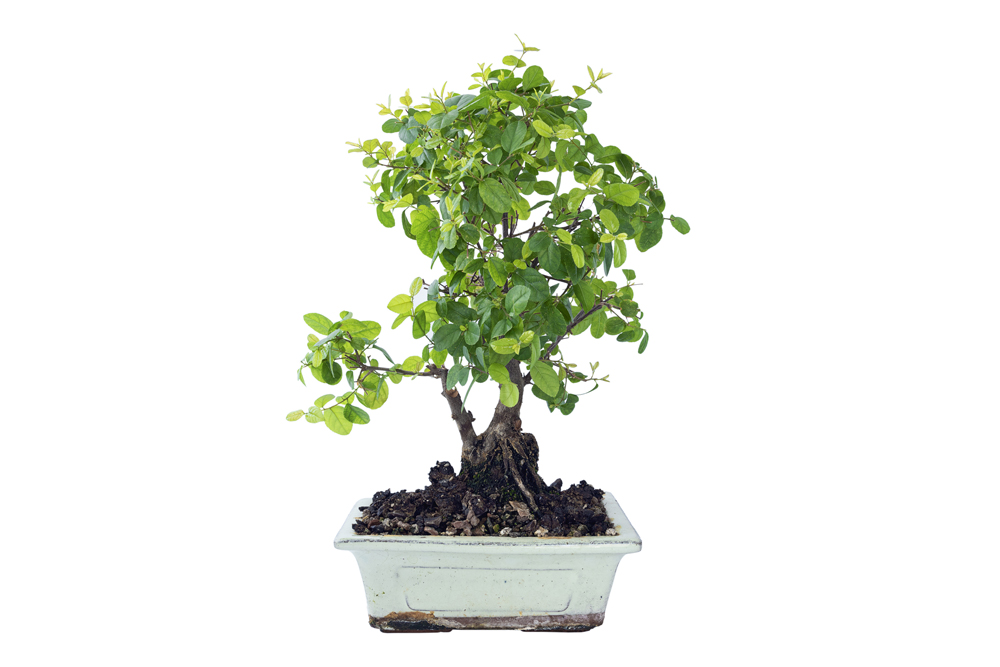Sageretia theezans
Common Name:
Chinese Sweet Plum

General Information:
Tropical plant. Very small leaves, exported from southern China. Bisexual, pinkish or whitish flowers with fruits that are drupes. Give winter protection. Sageretia thea (or Sageretia theezan), Poor Man’s Tea, Chinese Sweetplum, Shina Amai Ume.
This information was collected from a variety of sources including the posts of the Internet Bonsai Club. The format was taken from Sabrina Caine’s Tree-of-the-Week project. Thanks to Brent Walston of Evergreen Gardenworks for his assistance on determining the hardiness of this tree.
Sageretia thea is a bonsai subject with considerable visual appeal and a long history in the art. A tropical evergreen tree with naturally small leaves of less than 3/4 inch (2 cm) that reduce even smaller. The leaves are lightly veined, green leaves that are almost bronze when they emerge. Growth habit is stiff and angular with truly prolific back-budding. The Sageretia’s bark sheds while the tree is quite young and the trunk becomes multi- coloured with age. Small white flowers in spring give way to small black fruits (3-5 mm) during the summer and into autumn.
The Sageretia is very popular for indoor bonsai and a classical Chinese penjing subject. Lesniewicz’s “Bonsai in Your Home” features the Sweetplum as does Lewis’ “Bonsai Survival Manual”.
Lighting:
Full morning sun, shade in the afternoon/evening. Can take full sun all day but watering requirements increase dramatically. Beware of leaf burn when moving from shade to full sun.
Temperature:
The Sageretia is a subtropical tree and indoors needs a cool period coupled with lowered illumination. The tree should be held at 55-60 F for 6-8 weeks around the winter solstice. Once nighttime temperatures are consistently over 55 degrees, move tree outside.
In warmer climes, the Sageretia can be grown outdoors all year round. The Sageretia loses leaves at temperatures below 55F. It loses minor branches if the temperature dips below 25F. Below 25F the tree will experience major die back, but can recover (the tree buds easily from old wood, new wood, roots) Don’t try growing outdoors unless you’re in Zone 8 or higher.
Watering:
This tree enjoys slightly moist soil, but will wilt and die if allowed to dry out completely. Wilting can be recovered from only by a very healthy tree. Check moisture level everyday with chopstick or bamboo skewer.
Feeding:
Feed every 2 weeks in spring/summertime with Miracid. Slow feeding to once monthly in late autumn/winter. Alter feeding schedule to current light levels not temperature.
Pruning and wiring:
Usually only trained via the clip and growth method. The angular growth and extravagant back-budding make shaping easy. The tree supports all classical stylings easily. Weekly pinching of new growth is required to maintain completed form.
Propagation:
From cuttings or seeds. Rooting hormone is not needed for cutting, simply put the cutting into a glass of water for 2-4 weeks. Seeds do not require a vernalization period and can be germinated during any season.
Repotting:
Repot when fully root bound only. Typically, root pruning should be confined to 30% of root mass. Soil mixture must reflect moisture requirements, a 1:1:1:1 blend of peat/turface/pumice/coca shell gives a good blend of water retention and drainage.
Pests and diseases:
Danger of mealy bugs underneath the shedding bark. Spidermites due to lack of air circulation indoors. Fungus gnats can also be a problem indoors with the constantly moist soil. Treat with pyrethrin for all but spray twice, three days apart. Mealy bugs under the bark may require manual tweezer extraction to preserve the tree’s appearance.
Compiled by Sabrina Caine
